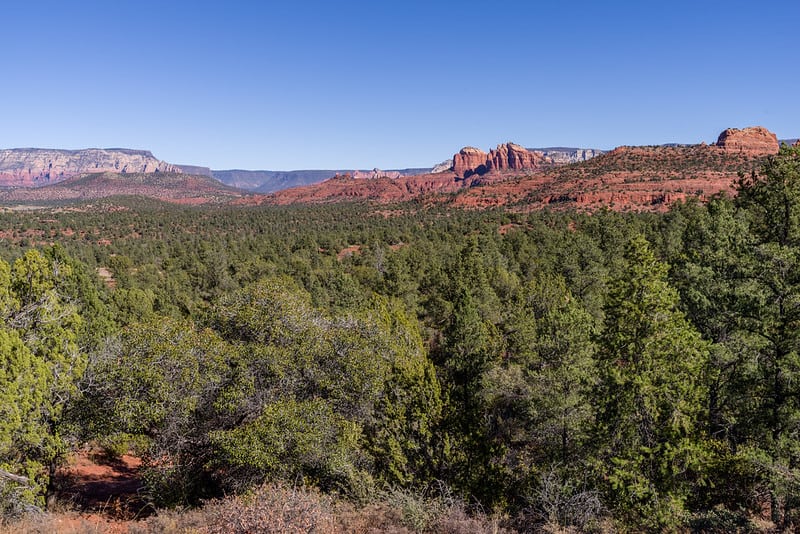
“The Forest Service’s most recent science shows that fire, insects and other factors are leading to large-scale losses in mature forests, not timber harvest. Reforestation needs similarly are being driven by large fires,” said Bill Imbergamo, executive director of the Federal Forest Resource Coalition (FFRC), which represents companies that harvest timber on federal land.
In it advanced notice of proposed rulemaking and request for comment to be published in the Federal Register, the Forest Service said the changed environment from wildfire, disease and insect pests is the “primary driver” of forest loss in the past 15 years, with wildfire accounting for more than 80 percent of reforestation needs. Most timber harvesting in national forests, which has declined sharply over the years, isn’t designed for commercial purposes, the agency said.
“To put this evolution of National Forest System management into context, currently the Forest Service commercially harvests one tenth of one percent of acres within the National Forest System each year. Harvests designed to improve stand health and resilience by reducing forest density or removing trees damaged by insect or disease make up 86 percent of those acres. The remainder are final or regeneration harvests that are designed to be followed by reforestation,” the Forest Service said.
Also this from NASA:
The nation’s old-growth forests encompass different tree species in different regions, from towering redwoods and 5,000-year-old bristlecone pines to diminutive pinyon junipers whose age and grandeur are less immediately obvious. For decades the U.S. Forest Service has studied such trees in hundreds of thousands of plots across the country, but the agency has never issued a formal accounting until now. To identify and define such forests, the team analyzed decades of field-gathered data from a wide variety of forest types and ecological zones, while also collecting public input in the process.
America’s forests help absorb more than 10% of our annual greenhouse gas emissions. While younger vegetation accumulates carbon more rapidly, old-growth forests contain more biomass overall and store more carbon. Not only are these ecosystems essential to the country’s clean air and water, they hold special significance to Tribal Nations, they sustain local economies, and they conserve biodiversity.
Complementing the Forest Service’s boots-on-the-ground research, some NASA-funded scientists are using a space-based instrument called GEDI (Global Ecosystem Dynamics Investigation) to provide a detailed picture of these forests. From its perch on the International Space Station, GEDI’s laser imager (lidar) is able to peer through dense canopies to observe nearly all of Earth’s temperate and tropical forests. By recording the way the laser pulses are reflected by the ground and by plant material (stems, branches, and leaves) at different heights, GEDI makes detailed measurements of the three-dimensional structure of the planet’s forests and fields. It can even estimate the weight, height, and vertical structure of trees.
“The partnership with NASA will help us do analyses we have not been able to do in the past,” said Jamie Barbour, who leads the old-growth initiative for the U.S. Forest Service. “From space, we’ll be able to drill down and learn about so many more places.”
……….
GEDI collected four years of forest observations around the world, before recently entering hibernation on the International Space Station. Extension of the GEDI mission is currently under discussion, and if the extension is approved, it is expected that monitoring of mature and old-growth forests will resume when it returns to service within two years.
This reminds me of the public forum I attended on MOG with the Forest Service, where many people wondered how useful an inventory is, and for what purposes, if not updated frequently.. like after wildfires take out old growth and mature trees. But maybe the point is to do “monitoring” over longer periods of time, perhaps with scientific but not direct policy relevance to local/regional forest management? It does seem to be a feature of our age.. collecting info and using it are not necessarily connected.
This NASA-USFS partnership is phenomenal to see. Another partnership this work might allow is one between scientists and managers designed to inform policy at several different scales. What I’m thinking is management actions, especially under a NEPA model, are like hypotheses: if we do *this*, we expect to see *that*.
Whether we call “that” desired outcomes or direct, indirect, or cumulative effects, it’s what we hope or anticipate from the actions proposed. Why not look at how Lidar and GEDI might help validate those management hypotheses?
Seems like the resulting science could be informed by management as much as managers and planners, and entire communities of interest, could be learn from that science. I’m even thinking the modeling work that is so invaluable could be improved by a tighter relationship.
Rather than science and management operating somewhat in parallel, as they so often do, they might find this work to open up at least a few more opportunities to pursue shared interests.
Google claims the ANPR is at this link:
https://www.usda.gov/media/press-releases/2023/04/20/biden-harris-administration-announces-new-steps-climate-resilience
but as of this writing it appears that usda.gov has suffered an unplanned disassembly. Maybe the link will work when usda.gov is once again functional.
Thanks!
E&E: Most timber harvesting in national forests, which has declined sharply over the years, isn’t designed for commercial purposes, the agency said… “Harvests designed to improve stand health and resilience by reducing forest density or removing trees damaged by insect or disease make up 86 percent of those acres. The remainder are final or regeneration harvests that are designed to be followed by reforestation,” the Forest Service said.
Why is what logging is “designed” to do relevant to the MOG question? If the Forest Service wants to achieve “stand health and resilience” by removing MOG, describing that as the “design” obscures the actual effects on MOG. All this seems to be saying is that most timber harvest is thinning rather than regen harvest, but that doesn’t mean it is not removing MOG (with “commercial” results).